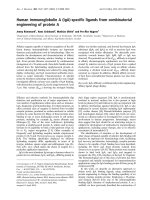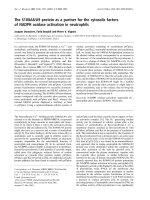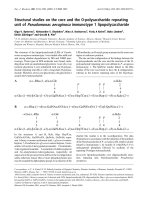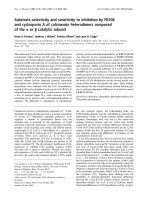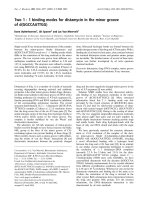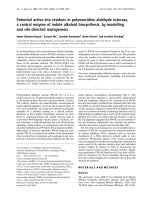Báo cáo y học: "Single food focus dietary guidance: lessons learned from an economic analysis of egg consumption" docx
Bạn đang xem bản rút gọn của tài liệu. Xem và tải ngay bản đầy đủ của tài liệu tại đây (272.21 KB, 7 trang )
BioMed Central
Page 1 of 7
(page number not for citation purposes)
Cost Effectiveness and Resource
Allocation
Open Access
Research
Single food focus dietary guidance: lessons learned from an
economic analysis of egg consumption
Jordana K Schmier*
1
, Leila M Barraj
2
and Nga L Tran
2
Address:
1
Exponent, 1800 Diagonal Road, Suite 300, Alexandria, VA 22314, USA and
2
Exponent, 1150 Connecticut Avenue, NW, Suite 1100,
Washington, DC 20036, USA
Email: Jordana K Schmier* - ; Leila M Barraj - ; Nga L Tran -
* Corresponding author
Abstract
Background: There is a large body of literature evaluating the impact of various nutrients of eggs
and their dietary cholesterol content on health conditions. There is also literature on the costs of
each condition associated with egg consumption. The goal of the present study is to synthesize
what is known about the risks and benefits of eggs and the associated costs from a societal
perspective.
Methods: A risk apportionment model estimated the increased risk for coronary heart disease
(CHD) attributable to egg cholesterol content, the decreased risk for other conditions (age-related
macular degeneration (AMD), cataract, neural tube defects, and sarcopenia) associated with egg
consumption, and a literature search identified the cost of illness of each condition. The base 795
case scenario calculated the costs or savings of each condition attributable to egg cholesterol or
nutrient content.
Results: Given the costs associated with CHD and the benefits associated with the other
conditions, the most likely scenario associated with eating an egg a day is savings of $2.82 billion
annually with uncertainty ranging from a net cost of $756 million to net savings up to $8.50 billion.
Conclusion: This study evaluating the economic impact of egg consumption suggests that public
health campaigns promoting limiting egg consumption as a means to reduce CHD risk would not
be cost-effective from a societal perspective when other benefits are considered. Public health
intervention that focuses on a single dietary constituent, and foods that are high in that constituent,
may lead to unintended consequences of removing other beneficial constituents and the net effect
may not be in its totality a desirable public health outcome. As newer data become available, the
model should be updated.
Introduction
High serum cholesterol levels are a major risk factor for
cardiovascular disease, but unlike other major risk factors
such as age, race, and gender, they can be modified to
some extent. Only about one-fourth of low-density lipo-
proteins in the body are associated with diet and the
remainder is produced by the liver or other cells in the
body [1]. The two major strategies for managing and/or
reducing cholesterol levels are a) pharmacological ther-
apy, and b) therapeutic lifestyle changes. Pharmacologic
Published: 14 April 2009
Cost Effectiveness and Resource Allocation 2009, 7:7 doi:10.1186/1478-7547-7-7
Received: 22 September 2008
Accepted: 14 April 2009
This article is available from: />© 2009 Schmier et al; licensee BioMed Central Ltd.
This is an Open Access article distributed under the terms of the Creative Commons Attribution License ( />),
which permits unrestricted use, distribution, and reproduction in any medium, provided the original work is properly cited.
Cost Effectiveness and Resource Allocation 2009, 7:7 />Page 2 of 7
(page number not for citation purposes)
therapies can include HMG CoA reductase inhibitors
(commonly known as statins), selective cholesterol
absorption inhibitors, renin inhibitors, fibrates, and
niacin. These medications can also be used in combina-
tion. Therapeutic lifestyle changes include smoking cessa-
tion, increasing physical activity, and modifying one's
diet, including keeping daily cholesterol intake less than
200 mg [2].
Dietary changes, while at first glance unequivocally posi-
tive, are not without possible detriments. Eliminating a
source of cholesterol from the diet may create an opportu-
nity for another, possibly more deleterious food. Also,
foods containing cholesterol also contain other compo-
nents, some of which may be beneficial. Balancing a
reduction in cholesterol intake with complete nutritional
needs is difficult and should consider maximizing other
potential benefits.
One food that has been scrutinized in particular in terms
of its nutritional value given its cholesterol content is the
egg. Eggs are a good source of high quality protein as well
as carotenoids such as lutein and zeaxanthin, and choline.
Consumers of eggs are more likely to meet their recom-
mended daily allowances of dietary folate and vitamins A,
E, and B
12
than non-egg consumers [3]. There is a large
body of literature evaluating the impact of both these
nutrients of eggs and their dietary cholesterol content on
health conditions, including ophthalmic conditions, cor-
onary heart disease, and neural tube defects, for example.
There is also literature on the costs of each condition asso-
ciated with egg consumption. The goal of the present
study is to synthesize what is known about the risks and
benefits of eggs and the associated costs. The basic frame-
work is the findings of the Health Professionals' Follow-
up Study (HPFS) and the Nurses' Health Study (NHS),
which evaluated the health effects of egg consumption
[4]. Using available data on the contribution of eggs to
various conditions and existing estimates of the costs of
each condition, this study estimates the economic impact
of consumption of one additional egg daily.
Methods
The analysis involved a multi-stage process. First, it was
necessary to identify the conditions associated with egg
consumption. Second, estimates of the contribution of
egg consumption to each health risk or benefit were
needed. Third, the economic impact of each of these con-
ditions was required. Finally, the cost estimates were
adjusted to reflect the contribution of eggs to each condi-
tion.
A literature search in PubMed was conducted to identify
the conditions associated with the nutrients in eggs for
which there was quantitative support. Based on the litera-
ture review, the proportion of each condition that would
be influenced by the addition of one egg daily was esti-
mated. A second PubMed search was conducted to iden-
tify publications estimating the costs of the conditions of
interest. Abstracts were reviewed to identify publications
with original data that assessed the cost of illness; reviews
and comparative cost studies were excluded. The estimates
were reviewed to determine the type of costs presented
(e.g., direct medical vs. lost productivity), the population
considered (e.g., Medicare-eligible vs. younger patients),
and the year in which costs were estimated (in order to
inflate to a common year).
For each condition, a "base case" was developed and a
sensitivity analysis was conducted, assuming the mini-
mum and maximum values as identified in the literature.
If there were no minimum or maximum values to use for
sensitivity analysis, the base case estimate was decreased
and increased by 25% in order to arrive at extreme values.
Similarly, if minimum and maximum values were availa-
ble but not a specific base case, the midpoint of these
extreme values was used as the base case input parameter.
Results
The literature search identified a wide range of estimates
for the costs of the conditions of interest, with various
methods used to develop these estimates. A listing of the
studies used to estimate costs and attribution in each area
is provided in Table 1. Additional file 1 provides details
on the methods for attribution.
Coronary heart disease
While the role of the overall diet to coronary heart disease
(CHD) risk is consistent, the evidence on dietary choles-
terol is not always clear [5]. Recent epidemiological evi-
dence has raised questions as to whether limiting dietary
cholesterol intake would lead to any significant reduction
in CHD risk [3,6-8]. Cholesterol feeding studies showed
that increasing dietary cholesterol increases both low den-
sity lipoprotein (LDL) and high density lipoprotein
(HDL) cholesterol with little change in the LDL:HDL
ratio. This offers partial explanation for the lack of find-
ings of an association between dietary cholesterol and cor-
onary heart diseases [9]. Multiple other risk factors,
including nonmodifiable ones such as age, gender, famil-
ial predisposition, and modifiable ones such as BMI and
smoking, affect risk for CHD. One study suggested that
blood cholesterol greater than 5.2 mmol/L may be associ-
ated with 43% of CHD in the United States in combina-
tion with other risk factors [10].
The American Heart Association estimates that the annual
total direct and indirect costs of cardiovascular disease
and stroke will be $448.5 billion in the United States in
2008 [11]. Both direct and indirect costs are included in
Cost Effectiveness and Resource Allocation 2009, 7:7 />Page 3 of 7
(page number not for citation purposes)
this total, with direct costs including hospital, nursing
home, physicians/other professionals, medical durables,
and home health care, and indirect costs including lost
productivity due to morbidity and mortality. CHD is
responsible for $156.4 billion of this total. More than half
(56%) of this is direct costs, while the remainder are indi-
rect costs
The proportion of disease attributable to the intake of one
egg daily is estimated at 0.3% based on recent evaluations
[12]. The estimate is the average of estimates of 0.1% and
0.5% associated with the consumption of one egg per day
(unpublished results, L. Barraj, N. Tran, P. Mink, D.
McNamara) and two eggs per day [12]. The cost of CHD
directly attributable to egg consumption was estimated at
$469 million, with a range of $117 million to $978 mil-
lion.
Age-related macular degeneration
A recent study using data from the 2002 National Health
Interview Survey estimated the prevalence of self-reported
eye diseases in the United States among adults 18 and
older [13]. Overall, the prevalence of AMD was 1.1%, sug-
gesting that there are 331, 906 people with AMD in the US
in 2007 [13].
Many studies have identified costs of AMD in the United
States. These studies have used two primary approaches:
claims data (generally from Medicare data) to identify
direct medical costs or patient surveys to identify direct
non-medical or indirect costs. Three studies are key to esti-
mating direct ophthalmic costs [14-16]. Gupta and col-
leagues present a recent summary of what is known about
the costs of AMD [17]. Halpern and colleagues [14] used
Medicare data from 1999 to 2001 and calculated the total
reimbursement per patient by AMD subtype. Rein and
colleagues used MarketScan and Medicare data to esti-
mate outpatient, inpatient, and prescription costs for
AMD patients 40 years and older [15]. Another study
comparing Medicare payments during two time periods
also estimated the costs for the first year after diagnosis vs.
follow-up costs [16]. Rehabilitation and counseling may
be included in claims databases, but are more generally
left out of cost analyses. Several studies have attempted to
quantify non-medical costs. Few studies have identified
non-medical costs associated with AMD in particular. The
use of devices and the costs of these devices, for example,
increased steadily as visual acuity decreased in patients
with AMD [18]. Similarly, the use of caregiving increased
as visual acuity decreased [19].
Based on the three studies that provided the comprehen-
sive estimates of AMD-related costs, the minimum and
maximum costs per case of AMD come to $599 to
$60,135 (2007$) annually for medical costs, patient-
reported services and devices, and caregiving. These esti-
mates inflate the values from Halpern et al. [14] on direct
medical costs from Medicare in 2001, with the minimum
cost representing drusen only and the maximum cost rep-
resenting wet AMD with photodynamic therapy. The sec-
ond study includes the patient-reported costs for services
and assistive devices associated with AMD with no visual
impairment ($323) to vision of 20/250 or worse ($677)
[19]. The third study reflects estimated costs for caregiving
for patients with no visual impairment ($259) to vision of
20/250 or worse ($54,120) [18]. Finally, Rein and col-
leagues estimated that the cost was $415 for patients age
40 to 64 years and $627 for adults 65 and older. Although
the prevalence of AMD is higher among older adults, to be
conservative, this analysis took the mean of these two age
group's costs.
After inflating costs to 2007 and multiplying these per-
case annual costs by the estimated number of patients
with AMD in the US, this analysis found that the reduc-
tion in expenditures associated with AMD resulting from
Table 1: Relevant studies
Condition Studies Used to Estimate Cost
(Base case, Min-Max)
Studies Used to Estimate Attribution
(Percent Attributed, Min-Max)
Coronary heart disease Rosamond et al., 2007 [11]
($156.4B, $117B-$196B)
Barraj et al. 2008 [12] (0.30%, 0.10%–0.50%)
Eye health: Age-related macular degeneration Halpern et al., 2006 [14]; Schmier et al., 2006a
[18]; Schmier et al., 2006b [19]; Salm et al., 2006
[16], 2006; Rein et al., 2006 [15]; Coleman &
Yu, 2008 [39] ($10.1B, $198.8 M-$19.96B)
Seddon et al., 1994 [35]; Handelman et al., 1999
[34]; Gale et al., 2003 [36]; Chung et al., 2004
[37] (9.5%, 4%–15%)
Eye health: Cataract Rein et al., 2006 [15]; Schmier et al., 2007a
(([21]; Schmier et al., 2007b [20]
($20.1B, $15.1B-$25.1B)
Handelman et al., 1999 [34]; Chasan-Taber et al.,
1999 [32]; Vu et al., 2006 [33] (11%, 1%–21%)
Muscle mass: Sarcopenia Janssen et al., 2004 [26]
($25.7 M, $16.1 M-$36.3 M)
Assumption (0.50%, 0.38%–0.63%)
Fetal health: Neural tube defects Ouyang et al., 2007 [40]; Robbins et al., 2007
[41] ($52.0 M, $39.0 M-$64.9 M)
Shaw et al., 2004 [29]; Zeisel 2000 [38]
(9%, 6.75%–11.25%)
Cost Effectiveness and Resource Allocation 2009, 7:7 />Page 4 of 7
(page number not for citation purposes)
adding an egg a day to the diet is $958 million, assuming
a 9.5% reduction in AMD. The impact could range from
$7.95 million (assuming per-patient costs of $599 with a
4% reduction in AMD) to $2.99 billion (assuming per-
patient costs of $60,135 with a 15% reduction in AMD)
(See Additional file 1.).
Cataract
Cataract s a fairly common disease among the elderly,
with a recent study reporting that 8.6% of all adults
reported being diagnosed with cataract during their life-
time [13]. The lifetime prevalence increases dramatically
with age, with 31% of adults age 65–74 and more than
53% of adults age 75 or older reporting having been diag-
nosed with cataract [13].
There is some information available about the cost of cat-
aract in the United States [15], and also some data on the
costs of common complications [20,21]. Rein and col-
leagues used data from MarketScan and Medicare to esti-
mate the cost per patient based on outpatient, inpatient,
and prescription medications for cataract. They estimated
that the cost was $6957 for patients age 40 to 64 years and
$6191 for adults 65 and older. The average of these two
costs was used for this analysis.
Complications from cataract surgery can be very expen-
sive. Two studies used Medicare data to estimate the incre-
mental costs associated with cystoid macular edema
(CME) and endophthalmitis after cataract surgery com-
pared to patients who underwent cataract surgery and did
not present with either complication. In 2005 dollars,
ophthalmic costs were $1055 higher for patients who
experienced CME and $3464 higher for patients with
endophthalmitis [20,21]. Although the rates of these
complications can vary, for the purpose of this estimate, it
was assumed that CME occurred among 16% of patients
(the midpoint of published estimates [22,23]) and endo-
phthalmitis occurred among 0.1% [24].
The cost savings associated cataract with adding an egg a
day to the diet were estimated at $2.21 billion, assuming
a reduction in cataract rates of 11% (the midpoint
between the low estimate of 1% and the high estimate of
21% (see Additional file 1) and per-patient annual costs
of $7556 plus incremental costs for two common compli-
cations (CME and endophthalmitis, multiplied by the
incidence of each complication).
Skeletal muscle mass
Sarcopenia, a degenerative loss of skeletal muscle mass, is
a common disease among older adults. Although difficult
to diagnose, as neither definitive diagnostic criteria nor
age-based thresholds exist, it is considered to be an impor-
tant cause of disability among older adults [25]. Multiple
causes may contribute to loss of muscle mass, and
improved nutrition, including intake of high-quality ani-
mal protein, is just one of the possible methods to defer
development of the condition and/or delay its progres-
sion.
One study was identified in the literature that estimated
the cost of illness for sarcopenia. Janssen and colleagues
[26] identified the costs of disability in the United States
using standard national survey data and then calculated
the fraction attributable to sarcopenia. They estimated
that 1.5% of total health expenditures (a total of $18.5
billion in 2000) were associated with sarcopenia. Reduc-
ing sarcopenia by 10% would reduce costs by $1.1 billion,
but this is dependent on whether that assumes patients
with moderate disease avoiding the condition, or those
with severe disease having a milder form [26].
While not enough is known about the epidemiology of
sarcopenia to attribute the proportion of cases that might
be prevented with the nutritional benefit of one egg daily
with a high degree of precision, this analysis assumed,
very conservatively, that 0.5% of cases of sarcopenia
might be averted. Given the annual cost estimate of $25.7
billion (inflating the estimate to 2007), a reduction of one
half percent of sarcopenia costs would result in $129 mil-
lion savings annually in the United States. If the reduction
were 25% less (an 0.45% reduction) or 25% greater (an
0.55% reduction), the savings would be $60 million to
$227 million, accordingly.
Neural tube defects
Many studies have evaluated the cost-benefit of folic acid
fortification and increased intake in recent years. It has
been suggested that if all women of child-bearing age were
to adhere to the CDC recommendation of taking 400 mg
of folic acid per day [27], approximately half of the annual
cases of NTDs would be avoided. Grosse and colleagues
compare and contrast existing studies and suggest that the
annual economic benefit of folic acid fortification is
between $312 to 425 million [28]. Based on Shaw et al
[29], we estimated that that 9% of NTDs could be elimi-
nated with the addition of one egg a day to the diet (see
Additional file 1); to provide a range, this analysis
assumed that the value could be 10% higher or lower. A
recent study estimated health care expenditures of
patients with spina bifida and found that total hospital
charges for infants with spina bifida, anencephaly, and
encephaloceles were $74.04 million, $1.1 million, and
$10.9 million (respectively) in 2003. The other studies
evaluated for this analysis included costs rather than
charges. To account for the fact that hospital charges are
greater than costs, an estimated cost-to-charge ratio was
applied, with charges multiplied by 0.5 to estimate costs.
Thus, after inflating costs to 2007 dollars, the estimated
Cost Effectiveness and Resource Allocation 2009, 7:7 />Page 5 of 7
(page number not for citation purposes)
savings in healthcare expenditures associated with preven-
tion of NTDs was $4.68 million, with a range from $2.63
to $7.31 million.
Total costs associated with egg consumption
Based on these calculations, considering the costs associ-
ated with egg consumption associated with CHD and the
benefits associated with AMD, cataract, neural tube
defects and sarcopenia, the estimated annual savings are
$2.82 billion annually (Table 2). Assuming the best case
scenario, in which egg consumption has the least impact
on CHD cost but the maximum impact on the other con-
ditions evaluated, it is estimated that the savings associ-
ated with consumption of an egg per day could be as great
as $8.39 billion. In the opposite scenario, in which egg
consumption has the greater impact on CHD costs and
the minimum impact on the other conditions evaluated,
it is estimated that egg consumption could result in a net
cost of $756 million annually.
Discussion
The results presented in this study must be interpreted
carefully. The two sources of data on which they are based,
economic studies and data on the contribution of choles-
terol to various conditions, are both subject to variation.
However, each of the estimates provided here includes
not only a base case value, but also a high and low value,
based on the literature where possible, so that the full
range of possibilities can be considered.
A number of limitations should be considered in terms of
the cost estimates used in this analysis. While the cost esti-
mates identified and used in this analysis were published,
that does not imply that they are comprehensive. For
example, no single economic study on any of the condi-
tions of interest captured all the costs one might attribute.
In most cases, direct medical costs are likely to be the pri-
mary source of disease-related costs, but lost productivity
cannot be overlooked. In the case of AMD, a series of stud-
ies captured a variety of costs: direct medical [14], caregiv-
ing [19] and use of assistive devices and services [18]. The
differences across studies make it difficult to compare lit-
erature-based values directly. Also, in the case of CHD, the
annual cost estimates provided by the American Heart
Association [11] address a wide variety of costs. The esti-
mate for NTD, while well-constructed, is based on hospi-
tal costs [30]. The conversion from costs to charges
reduces the precision of the estimate and the fact that the
estimate is limited to hospitalizations is another limita-
tion. It is also important to recognize that these factors
mean that the estimates presented here are necessarily
wide and still contain uncertainty. Future studies could
replicate the format of this analysis, eventually narrowing
the estimates. In the absence of such studies, this analysis
represents a reasonable approximation of the economic
impact of adding one egg daily to the diet.
This analysis also did not consider the cost of eggs. Com-
pared with other protein sources, they are reasonably
priced; we assumed zero additional cost for egg purchase.
As with any other food, proper cooking is essential to lim-
iting food-borne illness, particularly salmonella. The
cooking process may increase the digestibility of eggs as
well as reduce the possibility of illness. This model does
not assume any additional cost associated with cooking
eggs. Again, since other proteins that could be consumed
in place of eggs would likely require cooking, this omis-
sion is appropriate.
It should be noted that the estimate of the fraction of
CHD risk that can be attributed to eggs was based on an
apportionment analysis that included a number of modi-
fiable risk factors. One of the major considerations for
applying the risk apportionment approach is the selection
of appropriate risk factors and estimates of relative risks.
The apportionment model included only multivariate-
adjusted relative risk estimates derived from the same
population, mainly from the HPFS and NHS. Both were
chosen because they are large studies with long-follow-up
periods and carefully collected information, and because
the relative risk estimates were multivariate adjusted. It is
possible that different estimates of the share of eggs to
total CHD risk may have been derived if other assump-
tions were made about the potential interaction between
the various risk factors, if other factors were included, or if
risk estimates from other cohorts, e.g., population with
different education levels or without the health back-
ground the participants in the HPFS and NHS had. Fur-
ther the apportionment model used only considered the
cholesterol effects of an egg, without considering other
Table 2: Estimate of costs and benefits from egg consumption
Condition Annual Costs/Benefits Associated with Egg Consumption
Base case (Minimum, Maximum)
Comments
CHD $469 M ($117 M to $978 M) Medical and nonmedical costs
AMD -$958 M (-$7.95 M to -$2.99B) Medical and nonmedical (caregiving, assistive devices) costs
Cataract -$2.21B (-$151 M to -$5.28B) Medical costs only, includes two common complications
Sarcopenia -$129 M (-$60.4 M to -$227 M) Medical costs only
NTD -$4.68 M (-$2.63 M to -$7.31 M) Hospital charges
Cost Effectiveness and Resource Allocation 2009, 7:7 />Page 6 of 7
(page number not for citation purposes)
potentially beneficial components such as those described
in this paper. Another important limitation to this analy-
sis is the fact that considering any single food to the exclu-
sion of others is inherently problematic. Kritchevsky and
Kritchevsky [8] evaluated the studies estimating the rela-
tionship between egg consumption and coronary heart
disease and found that very few had adjusted for other
dietary intake (particularly total calories, fiber, and fat)
and advise caution in interpreting these types of studies.
Finally, it should be noted, that the published studies did
not find any association between CHD risk and egg con-
sumption, and there no statistically significant association
between dietary cholesterol and CHD was found in the
NHS and HPFS. The share of CHD attributed to eggs was
modeled based on the cholesterol content of eggs and
modeled association between dietary cholesterol, serum
cholesterol and CHD [31-41]. This approach is likely to
have resulted in an overestimate of the CHD risk estimate
associated with egg consumption.
The implications of these findings for public health are
two-fold. First, they echo those of several clinical studies
that suggest that moderate egg consumption may not be
harmful, and are indeed beneficial, among non-diabetic
and non-hypercholesterolemic individuals. Well meaning
public health campaigns designed to avoid eggs as a mean
to lower serum LDL cholesterol and reducing CHD risk
may be out of date and deserving of an update. If a cost-
effectiveness study were conducted to evaluate public
health campaigns limiting egg consumption as a means to
reduce CHD risk, it may very well be discovered that these
campaigns are not cost-effective from a societal perspec-
tive, particularly if the benefits of egg consumption are
considered. Second, the human diet is a complex mixture
of nutrients, antinutrients, functional components of var-
ying degree of biological activities. Public health interven-
tion that focuses on a single dietary constituent may lead
to unintended consequences of removing other beneficial
constituents and the net effect may not be a desirable pub-
lic health outcome. The development of other examples
would be a useful and interesting test of this hypothesis.
Conclusion
These findings suggest that public health campaigns pro-
moting limiting egg consumption as a means to reduce
CHD risk are not cost-effective from a societal perspective
when other benefits are considered. Public health inter-
ventions that focus on a single dietary constituent and
foods that are high in that constituent may lead to unin-
tended and undesirable consequences. As newer data
become available, the model presented here should be
updated. In particular, as there are conflicting data about
CHD, including data suggesting that there may not be an
increased risk, these findings may underestimate savings.
Competing interests
The authors have no competing interests. All authors are
employed at Exponent, Inc. Neither Exponent nor the
authors have any financial ties or interests to the organiza-
tion that provided funds to develop this manuscript, The
Egg Nutrition Center, nor is the authors' employment
dependent on the preparation or success of this project.
Authors' contributions
NT and LB were involved in the initial conception of the
project; JS helped refine the design. JS conducted the ini-
tial literature review and analysis; LB reviewed the calcula-
tions. JS drafted the manuscript; LB and NT provided
critical review and comment. All authors read and
approved the final manuscript.
Additional material
References
1. The two sources of cholesterol [ />presenter.jhtml?identifier=3046105]
2. Grundy SM, Becker D, Clark LT, Cooper RS, Denke MA, Howard WJ,
Hunninghake DB, Illingworth R, Luepker RV, McBride P, et al.: Detec-
tion, Evaluation, and Treatment of High Blood Cholesterol
in Adults (Adult Treatment Panel III) Final Report. NIH Pub-
lication 02-5215. National Institutes of Health 2002.
3. Song WO, Kerver JM: Nutritional contribution of eggs to
American diets. J Am Coll Nutr 2000, 19:556S-562S.
4. Hu FB, Stampfer MJ, Rimm EB, Manson JE, Ascherio A, Colditz GA,
Rosner BA, Spiegelman D, Speizer FE, Sacks FM, Hennekens CH, Wil-
lett WC: A prospective study of egg consumption and risk of
cardiovascular disease in men and women. JAMA 1999,
281:1387-1394.
5. Kratz M: Dietary cholesterol, atherosclerosis and coronary
heart disease. Handb Exp Pharmacol 2005:195-213.
6. Hu FB, Stampfer MJ, Manson JE, Rimm E, Colditz GA, Rosner BA,
Hennekens CH, Willett WC: Dietary fat intake and the risk of
coronary heart disease in women. N Engl J Med 1997,
337:1491-1499.
7. Howell WH, McNamara DJ, Tosca MA, Smith BT, Gaines JA: Plasma
lipid and lipoprotein responses to dietary fat and cholesterol:
a meta-analysis. Am J Clin Nutr 1997, 65:1747-1764.
8. Kritchevsky SB, Kritchevsky D: Egg consumption and coronary
heart disease: an epidemiologic overview. J Am Coll Nutr 2000,
19:549S-555S.
9. McNamara DJ: The impact of egg limitations on coronary
heart disease risk: do the numbers add up? J Am Coll Nutr 2000,
19:540S-548S.
10. Britton A, McPherson K: Monitoring the progress of the 2010
target for coronary heart disease mortality: estimated con-
sequences on CHD incidence and mortality from changing
prevalence of risk factors. London: National Heart Forum; 2000.
11. Rosamond W, Flegal K, Furie K, Go A, Greenlund K, Haase N, Hailp-
ern SM, Ho M, Howard V, Kissela B, Kittner S, Lloyd-Jones D, McDer-
mott M, Meigs J, Moy C, Nichol G, O'Donnell C, Roger V, Sorlie P,
Steinberger J, Thom T, Wilson M, Hong Y, American Heart Associa-
tion Statistics Committee and Stroke Statistics Subcommittee: Heart
disease and stroke statistics 2008 update. A report from the
Additional file 1
Quantifying egg benefits. Technical appendix.
Click here for file
[ />7547-7-7-S1.doc]
Publish with Bio Med Central and every
scientist can read your work free of charge
"BioMed Central will be the most significant development for
disseminating the results of biomedical research in our lifetime."
Sir Paul Nurse, Cancer Research UK
Your research papers will be:
available free of charge to the entire biomedical community
peer reviewed and published immediately upon acceptance
cited in PubMed and archived on PubMed Central
yours — you keep the copyright
Submit your manuscript here:
/>BioMedcentral
Cost Effectiveness and Resource Allocation 2009, 7:7 />Page 7 of 7
(page number not for citation purposes)
American Heart Association Statistics Committee and
Stroke Statistics Subcommittee. 2008, 117(4):e25-146.
12. Barraj L, Tran N, Goodman M, Ginevan M: Perspective: risk
apportionment and disease intervention strategies. Risk Anal-
ysis 2008, 28:477-486.
13. Ryskulova A, Turczyn K, Makuc DM, Cotch MF, Klein RJ, Janiszewski
R: Self-Reported Age-Related Eye Diseases and Visual
Impairment in the United States: Results of the 2002
National Health Interview Survey. Am J Public Health 2008,
98(3):454-61. Epub 2008 Jan 30
14. Halpern MT, Schmier JK, Covert D, Venkataraman K: Resource uti-
lization and costs of age-related macular degeneration.
Health Care Financ Rev 2006, 27:37-47.
15. Rein DB, Zhang P, Wirth KE, Lee PP, Hoerger TJ, McCall N, Klein R,
Tielsch JM, Vijan S, Saaddine J: The economic burden of major
adult visual disorders in the United States. Archives of Ophthal-
mology 2006, 124:1754-1760.
16. Salm M, Belsky D, Sloan FA: Trends in cost of major eye diseases
to Medicare, 1991 to 2000. Am J Ophthalmol 2006, 142:976-982.
17. Gupta OP, Brown GC, Brown MM: Age-related macular degen-
eration: the costs to society and the patient. Curr Opin Ophthal-
mol 2007, 18:201-205.
18. Schmier JK, Halpern MT, Covert DW, Delgado J, Sharma S: Impact
of visual impairment on service and device use by individuals
with age-related macular degeneration (AMD). Disabil Rehabil
2006, 28:1331-1337.
19. Schmier JK, Halpern MT, Covert D, Delgado J, Sharma S: Impact of
visual impairment on use of caregiving by individuals with
age-related macular degeneration. Retina 2006, 26:1056-1062.
20. Schmier JK, Halpern MT, Covert DW, Lau EC, Robin AL: Evaluation
of Medicare costs of endophthalmitis among patients after
cataract surgery. Ophthalmology 2007, 114:1094-1099.
21. Schmier JK, Halpern MT, Covert DW, Matthews GP: Evaluation of
costs for cystoid macular edema among patients after cata-
ract surgery.
Retina 2007, 27:621-628.
22. Rossetti L, Bujtar E, Castoldi D, Torrazza C, Orzalesi N: Effective-
ness of diclofenac eyedrops in reducing inflammation and
the incidence of cystoid macular edema after cataract sur-
gery. J Cataract Refract Surg 1996, 22(Suppl 1):794-799.
23. Krepler K, Biowski R, Schrey S, Jandrasits K, Wedrich A: Cataract
surgery in patients with diabetic retinopathy: visual out-
come, progression of diabetic retinopathy, and incidence of
diabetic macular oedema. Graefes Arch Clin Exp Ophthalmol 2002,
240:735-738.
24. Callegan MC, Engelbert M, Parke DW 2nd, Jett BD, Gilmore MS: Bac-
terial endophthalmitis: epidemiology, therapeutics, and bac-
terium-host interactions. Clin Microbiol Rev 2002, 15:111-124.
25. Baumgartner RN, Koehler KM, Gallagher D, Romero L, Heymsfield
SB, Ross RR, Garry PJ, Lindeman RD: Epidemiology of sarcopenia
among the elderly in New Mexico. Am J Epidemiol 1998,
147:755-763.
26. Janssen I, Shepard DS, Katzmarzyk PT, Roubenoff R: The health-
care costs of sarcopenia in the United States. J Am Geriatr Soc
2004, 52:80-85.
27. Centers for Disease Control and Prevention: Recommendations
for the use of folic acid to reduce the number of cases of
spina bifida and other neural tube defects. MMWR Recomm Rep
1992, 41(RR–14):1-7.
28. Grosse SD, Waitzman NJ, Romano PS, Mulinare J: Reevaluating the
benefits of folic acid fortification in the United States: eco-
nomic analysis, regulation, and public health. Am J Public Health
2005, 95:1917-1922.
29. Shaw GM, Carmichael SL, Yang W, Selvin S, Schaffer DM: Pericon-
ceptional dietary intake of choline and betaine and neural
tube defects in offspring. Am J Epidemiol 2004, 160:102-109.
30. Hospital stays, hospital charges, and in-hospital deaths
among infants with selected birth defects – United States,
2003. MMWR Morb Mortal Wkly Rep 2007, 56:25-29.
31. Barraj L, Tran N, Mink P, McNamara D: A comparison of egg con-
sumption with other modifiable coronary heart disease life-
style risk factors: a relative risk apportionment study.
Risk
Analysis 2009, 29:401-415.
32. Chasan-Taber L, Willett WC, Seddon JM, Stampfer MJ, Rosner B,
Colditz GA, Speizer FE, Hankinson SE: A prospective study of car-
otenoid and vitamin A intakes and risk of cataract extraction
in US women. Am J Clin Nutr 1999, 70:509-516.
33. Vu HT, Robman L, Hodge A, McCarty CA, Taylor HR: Lutein and
zeaxanthin and the risk of cataract: the Melbourne visual
impairment project. Invest Ophthalmol Vis Sci 2006, 47:3783-3786.
34. Handelman GJ, Nightingale ZD, Lichtenstein AH, Schaefer EJ, Blum-
berg JB: Lutein and zeaxanthin concentrations in plasma after
dietary supplementation with egg yolk. Am J Clin Nutr 1999,
70:247-251.
35. Seddon JM, Ajani UA, Sperduto RD, Hiller R, Blair N, Burton TC, Far-
ber MD, Gragoudas ES, Haller J, Miller DT, et al.: Dietary caroten-
oids, vitamins A, C, and E, and advanced age-related macular
degeneration. Eye Disease Case-Control Study Group. JAMA
1994, 272:1413-1420.
36. Gale CR, Hall NF, Phillips DI, Martyn CN: Lutein and zeaxanthin
status and risk of age-related macular degeneration. Invest
Ophthalmol Vis Sci 2003, 44:2461-2465.
37. Chung HY, Rasmussen HM, Johnson EJ: Lutein bioavailability is
higher from lutein-enriched eggs than from supplements
and spinach in men. J Nutr 2004, 134:1887-1893.
38. Zeisel SH: Choline: needed for normal development of mem-
ory. J Am Coll Nutr 2000, 19:528S-531S.
39. Coleman AL, Yu F: Eye-related medicare costs for patients
with age-related macular degeneration from 1995 to 1999.
Ophthalmology 2008, 115:18-25.
40. Ouyang L, Grosse SD, Armour BS, Waitzman NJ: Health care
expenditures of children and adults with spina bifida in a pri-
vately insured U.S. population. Birth Defects Res A Clin Mol Teratol
2007, 79:552-558.
41. Tilford JM, Grosse SD, Robbins JM, Pyne JM, Cleves MA, Hobbs CA:
Health state preference scores of children with spina bifida
and their caregivers.
Qual Life Res 2005, 14:1087-1098.


